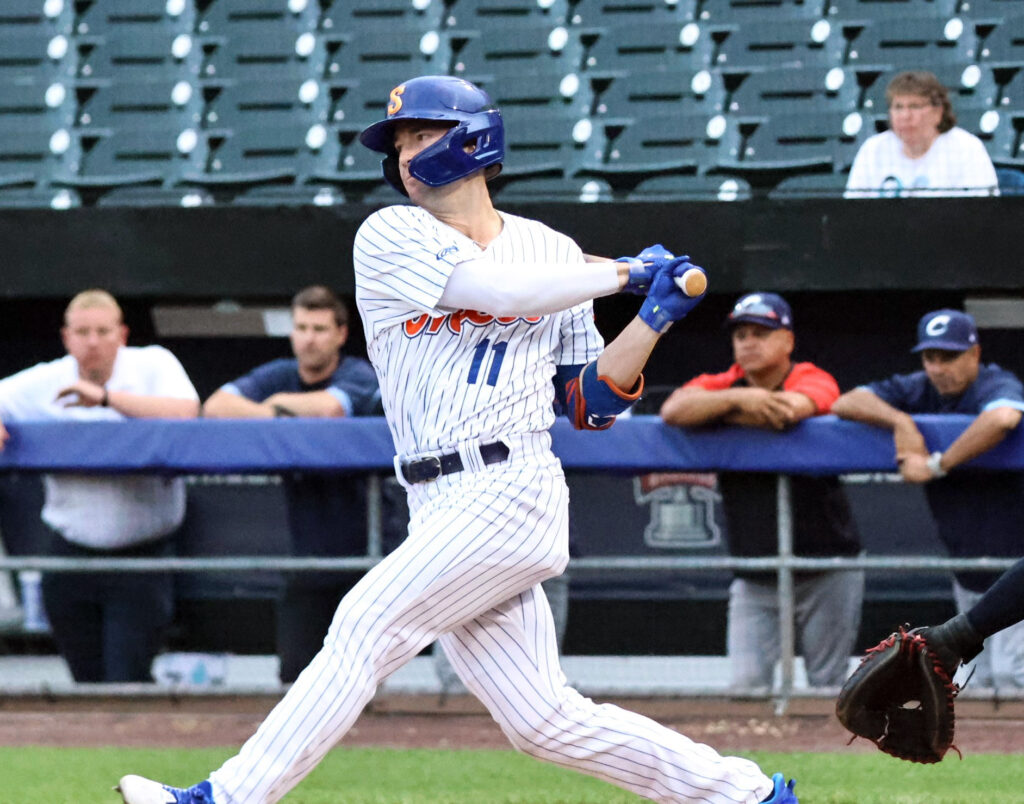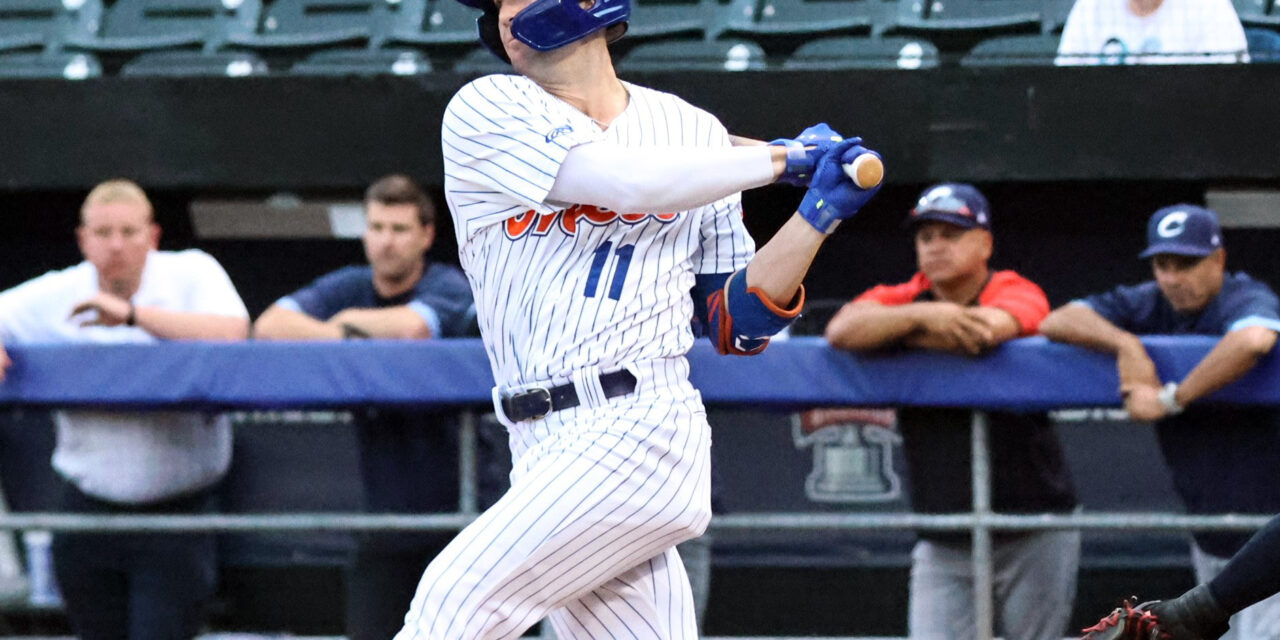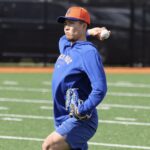As the Mets play out the string in 2023, most of the calls from fans have been to call up infielder Ronny Mauricio and/or starting pitcher Mike Vasil. While both of them certainly have their merits and are more highly thought-of prospects, I believe the Mets should bring up infielder Luke Ritter and outfielder Carlos Cortes.
Neither of them is generally considered a top-30 prospect in the Mets system right now, but both have played well this year overall and recently. And it makes more sense to give players you drafted a look at the end of a season instead of players in their 30s you signed to minor league deals.
Wasting At-Bats
On Thursday, when the Mets needed a player to replace the injured Mark Vientos, they selected the contract of 34-year-old Abraham Almonte from Triple-A Syracuse. Almonte was recently designated for assignment by the Mets after going 1-for-11 with seven strikeouts in four August games at the big league level. Meaning the Mets had to make a 40-man roster move to bring Almonte back, and they did so by moving Josh Walker to the 60-day IL.
The Mets are also starting 32-year-old Rafael Ortega regularly in the outfield. He has a 84 wRC+, and the early metrics on his defense have been subpar at -4 DRS and -1 OAA. Jonathan Araúz is another player getting regular starts for the Mets, and while he’s only 24 years old, he’s a career .187/.260/.311 hitter in the big leagues, and his overall offensive production of 92 wRC+ at Triple-A this year was also below average.
You could also certainly argue that the Mets are wasting at-bats on Daniel Vogelbach as well, given the likelihood of him being non-tendered this offseason after posting a 102 wRC+ this year as the Mets’ primary DH. Danny Mendick is an offseason non-tender candidate getting at-bats as well, he has an ugly .537 OPS in the majors this year, and in Triple-A, he was below average with a 92 wRC+. And you have 29-year-old DJ Stewart playing most days as well, and he joined the Mets on a minor league deal like Almonte, Ortega, and Araúz. Stewart is at least hitting well, with four home runs in 50 at-bats.
The overall point is the Mets are giving lots of at-bats right now to folks that are not in the plans for 2024 and could instead give those at-bats to players they drafted and/or developed in their farm system.

Luke Ritter, Photo by Herm Card
The Mets Should Get Looks at Young Talent
Ritter, 26, was the Mets seventh round pick in the 2019 draft. The right-handed hitter had been a league-average hitter wherever he played the last couple of seasons after a strong pro debut (122 wRC+) in Brooklyn in 2019. This season, he’s finally showing the power folks thought he had when he was drafted, and he leads the Mets minor leaguers with 24 long balls between Double-A (10) and Triple-A (14). He does strike out quite a bit, around 30%, but also walks around 15%.
Things really clicked for Ritter in June when he had seven home runs in a seven-game span for Binghamton that, earned him a promotion back to Triple-A. Since June 4, combined between the two levels, Ritter has been hitting .276/.378/.537 with a 129 wRC+. Ritter has played all four infield spots this year and even one game in left field. He’s most comfortable at second base, where he’s an average defender and has played a fair amount of corner infield as well.
Cortes, 26, was drafted by the Mets in the third round of the 2018 draft. The ambidextrous thrower began his pro career playing exclusively second base, but has played only the outfield the last two seasons. He has played all three outfield spots this year, though he’s at his best in left field, where he is a solid defender. The left-handed hitter has always been known for his offensive skills, though. He proved that in his first three seasons at the pro level with 116 wRC+ his first season, 119 wRC+ in his second, and 120 wRC+ in his third year with Double-A Binghamton.
The Mets thought Cortes was ready for Triple-A Syracuse to start the 2022 season, given his pro success through the system. Unfortunately for Cortes, Triple-A turned out to be a significant struggle (24 wRC+), and he found himself back in Double-A. He struggled in the return to Double-A as well. After a strong spring this year, the Mets gave Cortes another chance at Triple-A. It was a bad start for Carlos with a .642 OPS in April and better but still below average (the International League has been a launching pad this year) .781 OPS in May.
The calendar changed over to June and Cortes hasn’t stopped hitting since. Cortes has a .297/.400/.579 slash line with a 139 wRC+ since June 9 for Syracuse. During that span, Cortes has walked 14% of the time and struck out only 18% of the time. The home run power has been even better in August, and he has five home runs in his last 30 at-bats.
Again, neither of these guys are young top-echelon prospects, but they are homegrown players that have posted better offensive numbers in Triple-A this year than many of the older players the Mets are deciding to give at-bats to right now.
I should also mention that 25-year-old Brandon McIlwain has been tearing the cover off the ball in 13 games since his promotion to Triple-A. The former D1 quarterback has a 129 wRC+ with more walks (11) than strikeouts (9) and has stolen five bases for Syracuse. McIlwain is a great athlete that has cut down on his strikeouts this season and has shown the ability to play a good center field as he continues to acclimate himself to playing football full-time.
Ritter, Cortes, and McIlwain are all Rule 5 eligible this offseason as well, meaning it makes sense for the Mets to get a look at the big league level for all of them.















